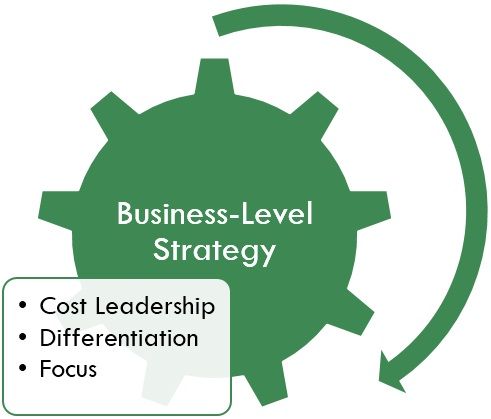Definition: Business level strategies refer to the combined set of moves and actions taken with an aim of offering value to the customers and developing a competitive advantage, by using the firm’s core competencies, in the individual product or service market. It determines the market position of the enterprise, in relation to its rivals.
Business-Level Strategies are mainly concerned with the firms having multiple businesses and each business is considered as Strategic Business Unit (SBU).
It determines how the firm is going to compete in the market within each Line of Business, i.e. SBU. Further, it focuses on how the firm will compete successfully in each line of business and how to effectively manage the interest and operations of a specific unit.
So, these strategies are the course of action selected by a firm for each line of business or SBU individually and intend to attain competitive advantage, in separate lines of business, which the firm is having in its portfolio currently.
Business level strategies deal with the following issues:
- Satisfying the needs of the customers.
- Achieving an edge over its rivals.
- Avoiding a competitive disadvantage.
Strategies at this level are concerned with meeting competition, defending market share while making a profit.
A firm is said to have a competitive advantage if it can attract the target customers, as well as survive the competitive forces better, as compared to the rivals.
Business Level Strategies
Effective Business-Level Strategies entails developing distinctive competencies and implementing them in order to have an upper hand over its rivals. Michael Porter has propounded three business-level strategies in the year 1998, which are discussed as under:
Cost Leadership
This strategy stresses on manufacturing standardized products, at a low cost for the price-sensitive consumers.
Cost leadership strategy tends to focus on the broad mass market. And for this, the firm continuously and rigorously strives for cost reduction in different areas, whether it is procurement, production, packaging, storage, distribution of the product while achieving economies in overheads.
To gain cost leadership, firms often follow forward, backward and horizontal integration.
Ways to achieve Cost leadership
- Quick demand forecasting for the product or service.
- Effective utilization of the firm’s resources to avoid wastage.
- Attaining economies of scale which results in lower per-unit cost.
- Investing in high-end technology for smart working.
- Product standardization for mass production, which leads to economies of scale.
Differentiation
As the name suggests, differentiation strategy aims at producing and offering industry-wide distinctive products and services to the customers, so as to target price-insensitive customers.
This strategy is also directed for the broad mass market, which encompasses the development of a unique product. Unique means uniqueness with respect to design, brand image, specifications, customer service, technology used, etc.
Further, this strategy may or may not lead to competitive advantage, mainly because the customer’s needs are satisfied by standard products or if the rivals imitate the product or service quickly.
Hence, the strategy should be followed after proper market research and study of the buyers to ascertain their needs and preferences and adding differentiating features to the product.
Ways to achieve Differentiation
- Providing utility to the customers that match their taste and preference.
- Increasing product performance.
- Product innovation
- Setting up product prices on the basis of differentiated features of the product and affordability of the customers.
Focus
This strategy is used by the firms to produce products and services, which fulfils the need of small consumer groups. The strategy relies on the segment of the industry which is considerable in size, higher growth potential and not important to the success of the rivals.
This is commonly used by small or medium-sized enterprises. This strategy works only when consumers have varied tastes and competitors does not try to specialize in that particular segment.
Ways to achieve Focus
- Choosing a particular niche, often avoided by cost leaders and differentiators.
- Excel in catering to the specific niche.
- High-efficiency generation to serve those niche.
- Creating new ways for the value chain management.
Business-Level Strategy shows the choices made by the firm with regard to the way in which the firm contemplates to compete in the market.
The firm’s core competencies should focus on the needs and wants of the customers, with an aim or attaining extraordinary returns. And to attain this, business-level strategies play an important role.
Business level strategies aims at developing the competitive advantage, ascertaining responses with respect to the changing market trends, allocation of resources within the SBU.

Sal says
Thanks for this simple but informative article.
Emmah says
Thanks a bunch business jargons for demystifying these concepts.